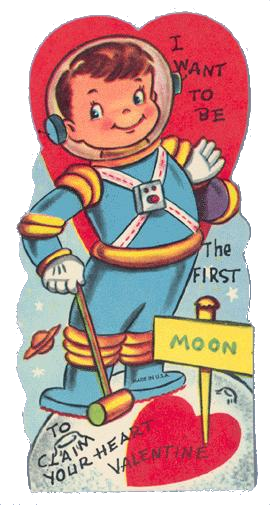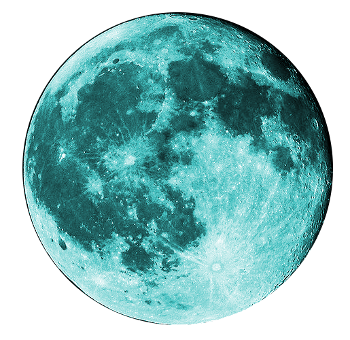Moonstruck
April 16, 2015
The
Moon hangs heavy in our sky and our
culture, and the Moon must surely have affected the
evolution of life on
Earth through the tides. As I wrote in a recent article (Assisting Abiogenesis, March 16, 2015),
Charles Darwin believed that the
abiogenesis of life (the transition from non-living to living
matter) happened in a "warm little pond,"[1] likely stocked and restocked with
reagents from tidal flow.[2-4] Our rapid tidal cycle would have helped in the formation of the
polymer precursors to
nucleic acids by
concentrating salt.[5]
As I wrote in an
earlier article (General Lunacy, August 9, 2013), the Moon appears to have an influence on some
organisms, through such things as its modulation of
night time illumination. Not surprisingly, the
natural rhythms of
aquatic animals have been found to be synchronized to the
lunar month.[6] There's lunar periodicity in the
breeding of the scallop,[7] the population of several species of flying insect,[8] and the human menstrual cycle.[9-10]
Somewhat more controversial is the affect of the Moon on
human behavior. As an examination of
language illustrates, people are fairly certain that it does. We have the word,
lunatic, a word derived from the
Latin adjective,
lunaticus, translated as "of the moon," or "moonstruck."[11] In
folklore, strange things are more likely to happen to humans at the time of the
full Moon.

I exchanged valentines like this when I was a child.
The Moon has been associated with romance, possibly because the mythological personification of the Moon was a goddess, Selene.
In various myths, Selene was romantically involved with Zeus, Pan, and the human, Endymion. She was a popular subject of portrait artists, and as good an excuse as any for painting a nude.
(Via Wikimedia Commons.)
Scientists have done some studies in an attempt to untangle folklore from
fact. In one study, they used
electroencephalography to measure the delta-wave activity of the brain during
non-rapid-eye-movement (NREM) sleep to monitor the affect of the lunar cycle on sleep.[12-15] Delta-wave activity during NREM sleep is an indicator of
deep sleep.
They found that delta wave activity decreased by 30% at the time of the full moon; that is, sleep becomes more difficult at the time of the full Moon. Not only that, but it took about five minutes longer for the study subjects to fall asleep, and the duration of sleep was reduced by twenty minutes, at the time of the full Moon.[12-15]
Increased night time illumination was not the cause, since the study subjects couldn't see the Moon. The effect must be linked to a human
biological clock, possibly a relict of our
ancestors, who needed to be more alert for
predators when the Moon was full.

Blue Moon
A blue Moon is commonly defined as the second full Moon in a calendar month. In 2015, full Moons will appear on
July 2 and July 31.
(Wikimedia Commons image by Peter Freiman, modified for artistic effect.)
There's an
old wives' tale of more
births at the time of the full Moon, and a 2004 study of a
Barcelona, Spain,
hospital found a
correlation between admissions related to
gastrointestinal bleeding and the lunar cycle.[16] However,
Jean-Luc Margot, a
professor of
planetary astronomy at
UCLA, did a more critical review, and he insists that the correlation is not present.[17-19] In a study, published online in the
journal,
Nursing Research, Margot addresses the
fallacy, as believed by some
nursing professionals, that the Moon has an affect on such things as
birth rates,
blood loss, and
fertility.[17-19]

Jean-Luc Margot
(UCLA image, courtesy of Jean-Luc Margot.)
The 2004 Barcelona study analyzed the data for 447 consecutive
gastrointestinal hemorrhage patients over a two year period. It was found that there were 26 admissions on the 25 days of full moon and 421 admissions in the remaining 713 days.[16] Since
26/25 = 1.04, and 421/713 = 0.59, there appears to be a higher incidence at full moon. The authors proposed the strength of the lunar tides as an explanation.[19]
Margot's reanalysis of their data using proper
statistics and
controls showed no evidence of a full moon effect, a result that he points out is consistent with quite a few other
peer-reviewed studies.[17] Margot says that the problem with most studies of such "lunar effects" is errors in
methodology, and in
cognitive biases that lead to erroneous conclusions.[17]
As a first problem, the
lunar cycle is variable, and it had a minimum value of 29.28 days, and a maximum value of 29.80 days, over the course of the study, while the study used an even 29 days.[19] Furthermore, the
authors didn't consider other potential periodicities, such as any for
day of the week. Failure to consider such other effects was shown to invalidate a study of lunar effect in
automobile accidents. The study used a low level of
statistical confidence.[19]
Blaming the lunar tides is invalid for a number of reasons. First, the strongest tidal effects occurs at both the full and
new Moon, while the data showed no effect at new Moon.[19] Ordinary nearby objects, such a
building, would produce an
orders of magnitude stronger
tidal force on humans than would the Moon.[19] Tidal force is
proportional to the
mass of the body inducing the tide, and
inversely proportional to the
third power of the distance from that body.
Going back to the
idea that there are more births at the full Moon, a 1979 study of 8,142 natural births (those not induced by
drugs or
Caesarean sections), from 1974 to 1978 at the
University of California, Los Angeles hospital, showed no correlation with lunar phase.[20] Margot recommends
Thomas Gilovich’s 1991 book, "How We Know What Isn't So," as a good reference about other popular misconceptions.[21] A summary of that book appears
here.
References:
- As quoted by Darwin's son, Francis, in The life and letters of Charles Darwin, 1887.
- Carlo Denis, "Archaean tides and the origin of life," National Museum for Natural History, Luxembourg (PDF File).
- Richard Lathe, "Fast tidal cycling and the origin of life," Icarus, vol. 168, no. 1 (March, 2004), pp. 18-22.
- Anil Ananthaswamy, "No Moon, no life on Earth, suggests theory," New Scientist, March 18, 2004.
- Bruce Dorminey, "Without the Moon, Would There Be Life on Earth?" Scientific American, April 21, 2009.
- R. M. McDowall, "Lunar Rhythms in Aquatic Animals A General Review," Tuatara, vol. 17, no. 3 (December, 1969), pp. 133-143.
- James Mason, "A possible lunar periodicity in the breeding of the scallop, Pecten maximus (L.)," Journal of Natural History, ser. 13, vol. 1, no. 9 (1958), pp. 601-602.
- W. Danthanarayana, "Lunar Periodicity of Insect Flight and Migration," Proceedings in Life Sciences (1986), pp. 88-119.
- Winnifred B. Cutler, "Lunar and Menstrual Phase Locking," American Journal of Obstetrics and Gynecology, vol. 137 (1980), p. 834.
- Winnifred B. Cutle, Wolfgang M. Schleidt, Erika Freidmann, George Preti and Robert Stine, "Lunar Influences on the Reproductive Cycle in Women," Human Biology, vol. 59, no. 6 (December 1987).
- Moonstruck is a 1987 film directed by Norman Jewison. Cher won the Best Actress Academy Award for her performance, and Olympia Dukakis received an award for Best Supporting Actress.
- Christian Cajochen, Songül Altanay-Ekici, Mirjam Münch, Sylvia Frey, Vera Knoblauch and Anna Wirz-Justice, "Evidence that the Lunar Cycle Influences Human Sleep," Current Biology, vol. 23, no. 15 (August 5, 2013), pp. 1485-1488, DOI:10.1016/j.cub.2013.06.029.
- Bad sleep around full moon is no longer a myth, University of Basel Press Release, July 25, 2013.
- Michelle Roberts, "Full Moon 'disturbs a good night's sleep'," BBC News, July 25, 2013.
- Sarah C. P. Williams, "Yes, You Can Blame the Moon for a Bad Night's Sleep," Science, July 25, 2013.
- Eva María Román, Germán Soriano, Mercedes Fuentes, María Luz Gálvez, andClotilde Fernández, "The influence of the full moon on the number of admissions related to gastrointestinal bleeding," International Journal of Nursing Practice, vol. 10, no. 6 (December, 2004), pp. 292-296, doi:10.1111/j.1440-172x.2004.00492.x
- Margot, Jean-Luc, "No Evidence of Purported Lunar Effect on Hospital Admission Rates or Birth Rates," Nursing Research, vol. 23, no. 1 (March, 2015). This is an open access article with a PDF file available here.
- Jean-Luc Margot, "There Was a Full Moon and Nothing Happened . . . Again," UCLA Web Site, March 29, 2015.
- Stuart Wolpert, "Stop blaming the moon, says UCLA scientist - Study highlights flaws in earlier research on hospital admissions and the lunar cycle," UCLA Press Release, March 30, 2015.
- G.O. Abell and B. Greenspan, "Human births and the phase of the moon [Letter]," New England Journal of Medicine, vol. 300 (January 11, 1979), p. 96, DOI: 10.1056/NEJM197901113000223.
- Thomas Gilovich, "How We Know What Isn't So: The Fallibility of Human Reason in Everyday Life," Free Press; Reprint edition (March 5, 1993), 224 pp. (via Amazon).
Permanent Link to this article
Linked Keywords: Moon; sky; culture; evolution of life; Earth; tide; Charles Darwin; abiogenesis; matter; chemical compound; reagent; fluid dynamics; flow; polymer; precursor; nucleic acid; concentration; salt; lunacy; organism; night; illumination; natural; rhythm; aquatic animal; synchronization; synchronize; lunar month; periodic function; periodicity; breeding; scallop; species; Pterygota; flying insect; human menstrual cycle; controversy; controversial; human behavior; language; lunatic; Latin; adjective; folklore; full Moon; valentine; child; romance; mythology; mythological; anthropomorphism; personification; goddess; Selene; myth; Zeus; Pan; human; Endymion; portrait painting; portrait artist; nude; Wikimedia Commons; scientist; fact; electroencephalography; delta-wave; brain; non-rapid-eye-movement; sleep; slow-wave sleep; deep sleep; circadian rhythm; biological clock; relict; ancestor; predation; predator; Blue Moon; calendar month; old wives' tale; birth; Barcelona, Spain; hospital; correlation; gastrointestinal bleeding; Jean-Luc Margot; professor; planetary science; planetary astronomy; University of California, Los Angeles; UCLA; scientific journal; Nursing Research; fallacy; nursing professional; birth rate; bleeding; blood loss; fertility; Jean-Luc Margot; gastrointestinal hemorrhage; patient; statistics; control; peer review; methodology; cognitive bias; lunar phase; lunar cycle; author; day of the week; traffic collision; automobile accident; confidence interval; statistical confidence; new Moon; building; orders of magnitude; tidal force; proportionality; proportional; mass; inverse; cube; third power; idea; pharmaceutical drug; Caesarean section; University of California, Los Angeles hospital; Thomas Gilovich, "How We Know What Isn't So: The Fallibility of Human Reason in Everyday Life."